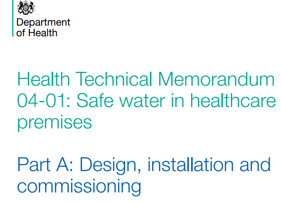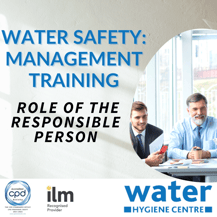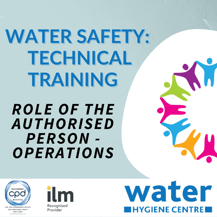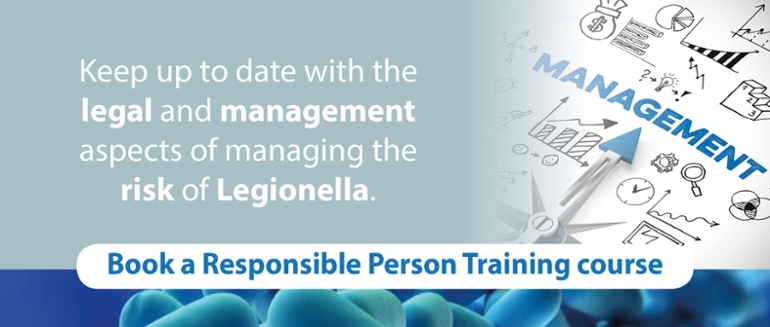In this blog, we explore the various roles that exist within an organisation's water safety team and who is the most appropriate person to be appointed to fill each of these positions.
To the uninitiated, RP equates to ‘Responsible Person’, DRP the ‘Deputy Responsible Person’, AP the ‘Authorised Person’, and CP, the ‘Competent Person’. All these ‘formal’ roles are documented within current relevant HSE and Dept. of Health HTM] water safety guidance.
The first point of clarity is, what are these positions and are they needed? The Approved Code of Practice (ACoP) L8, identifies an absolute requirement for the Duty Holder to nominate, or formally appoint, a competent person typically known as the ‘Responsible Person’ (RP).
What are the ACoP L8 and HTM 04-01 and what does the Guidance Say?
The ACoP L8 applies to all organisations that have a foreseeable risk of Legionnaires’ disease to manage.
For healthcare organisations, there is additional guidance in the form of the Health Technical Memorandum (HTM) “HTM04-01 – Safe water in healthcare premises” and the Scottish HTM “SHTM04-01 – water safety in healthcare premises”. Both SHTM04-01 and HTM04-01 include detailed guidance on ‘Operational Management’; which is contained in Part B of both publications.
SHTM04-01 Part B details a host of positions that may exist within water safety management. However, the revisions to HTM04-01 in 2016 saw the removal of most of the roles identified in the previous version. This approach was preferred by the authors, on the basis that it is thought to encourage healthcare organisations to identify the specific individuals involved in water safety management within their organisation.
 When it comes to any of the typically designated roles, organisations following the ‘holistic’ approach of HTM04-01 should initially be identifying those involved in water safety management. This can be achieved starting with the organisation's ‘communications pathway’; a flow chart of the personnel directly and indirectly involved in water safety management within the organisation. Once, these people have been identified, then you can define their specific roles and responsibilities and ensure the right person is in post.
When it comes to any of the typically designated roles, organisations following the ‘holistic’ approach of HTM04-01 should initially be identifying those involved in water safety management. This can be achieved starting with the organisation's ‘communications pathway’; a flow chart of the personnel directly and indirectly involved in water safety management within the organisation. Once, these people have been identified, then you can define their specific roles and responsibilities and ensure the right person is in post.
Any formal appointment within an organisation [accepting the RP role, necessary in all scenarios] is very much organisation-specific in terms of ‘who’ may hold these roles.
Appointments may be dependent upon:
- The size and complexity of the organisation. Smaller or less complex organisations may require fewer appointments. I.e. a flattened management structure.
- The ‘type’ of organisation. i.e. Healthcare, for example, may determine the ‘composition’ of clinical and non-clinical involvement in the management of water quality.
- How the organisation is set up to manage water safety.
- The level of resources available so that staff members can fully invest in these positions.
How will your Water Safety Plan help?
Within an organisation, multiple positions of authority and responsibility may exist for water safety. The organisation’s Water Safety Plan (WSP) should detail the approach and strategies to be employed. The Management/Governance Policy section of the WSP is the most appropriate element to define the roles and their associated responsibilities, which will be supported by a ‘Communications Pathway’.
Let’s now start to think about these positions and who the most appropriate person might be. Remember, depending on the people identified within the Communications Pathway, these positions and titles will vary between organisations.
Responsible Person - Water (RP):
The RP is a position of authority, competence, and knowledge whose role it is to ensure that suitable and sufficient management arrangements are in place.
 For example, the RP will ensure that there is a Water Safety Plan (WSP) and that water systems are maintained in such a way as to mitigate the risk of ‘preventable’ waterborne diseases such as Legionnaires’ disease.
For example, the RP will ensure that there is a Water Safety Plan (WSP) and that water systems are maintained in such a way as to mitigate the risk of ‘preventable’ waterborne diseases such as Legionnaires’ disease.
Therefore, whilst the organisation and Duty Holder hold accountability, the RP will be someone who holds management responsibilities for the water systems i.e. maintenance, monitoring, and operation. The role of RP may be delivered by a senior individual within the Estates management team (such as the Head of Estates).
Deputy Responsible Person - Water (DRP):
Depending on the size and complexity of the organisation, the RP may require assistance with aspects of their role. For example, the operational delivery of the maintenance programme defined in the WSP may be delegated to a deputy. The role of this DRP may be delivered by an Estates Officer, often with a mechanical bias, and who has responsibility for water systems safety.
The DRP might be responsible for the correct maintenance, monitoring, and operation of water systems. Included in this role is the need to report the level of compliance for water systems within the estate to the RP, including the status of the Legionella risk assessment (LRA). i.e. having an LRA in place, ensuring RA action plan deadlines are achieved, and identifying when a new risk assessment is required.
Authorised Person - Water (AP):
 An AP may also be required to assist with the execution of routine operational tasks throughout the estate such as pre-planned/reactive maintenance and the management of suitable records (monitoring data). The role of the AP may be delivered by an Estates Supervisor.
An AP may also be required to assist with the execution of routine operational tasks throughout the estate such as pre-planned/reactive maintenance and the management of suitable records (monitoring data). The role of the AP may be delivered by an Estates Supervisor.
APs will invariably review monitoring/performance data returned by the Competent Persons and identify any failures for resolution. APs will also typically assist with the commissioning of site-specific Legionella risk assessments.
Competent Persons - Water (CP):
Those that have the role of CP are typically tradespersons and may be employees or contractors. In either case, it’s once again important to ensure that CPs are suitably trained and competent to complete the tasks for which they have been employed or commissioned. These tasks comprise the actual delivery of the maintenance, testing, and inspection regimes, including among other tasks: flushing, temperature monitoring, water sampling, chemical testing & treatments, tank inspections, installation, repairs, alterations, and other plumbing work.
Competency
Within water safety, ‘competency’ is a crucial metric that underpins the appointment of an individual or individuals to hold certain positions. An organisation should ensure suitable and sufficient Legionella training has been completed by personnel identified within the water safety management structure. Those identified should be able to demonstrate the key competencies that are required to fulfill the responsibilities of their role/position.
Such competencies should be appraised and may be demonstrated by (but not limited to): the completion of a suitable water hygiene course to ensure that required skills remain up to date, the attainment of role-specific qualifications, and the demonstration of job-specific knowledge and experience.
Summary
Not all organisations are the same, however, following the HSE’s ACOP L8 all organisations should appoint a Responsible Person (RP) to manage the risk. The RP may delegate duties and tasks to other individuals within the organisation and where this is the case those other individuals must be identified within the communications pathway and their roles and responsibilities defined within the organisation’s management policy.
Feel free to reach out if you have any questions about this blog or if you would like to consult with one of our experts for further advice on water hygiene.
Editors Note: The information provided in this blog is correct at the date of original publication - October 2018. (Revised February 2024)
© Water Hygiene Centre 2024









